Experience the sublime temples of Chiang Mai
By Jennifer Legate
The beauty of Chiang Mai, aside from the old city walls and the charm of its moat and river, lies in its temples. There are over 30 temples within the city walls, and far more in the outlying areas of Chiang Mai. Join me on a mini tour of some of the most beautiful temples in the Chiang Mai area: Wat Doi Suthep, Wat Chedi Luang Worawihan, Wat Lok Molee, Wat Bupparam, and Wat’s Chedi Liem and Chang Kam in the ancient, legendary city below the city of Chiang Mai, Wiang Kum Kam.
Thai temples are undeniably beautiful. A great way to soak up Thailand’s splendour and its culture is through its temples. Chiang Mai, in particular, has a distinctive, varied temple culture. Each temple has its own focus, yet there are over 30 temples within the city walls and at least 300 throughout the greater Chiang Mai area.
‘The Lanna “Kingdom of a million rice fields” at one time encompassed Northern Thai, Lao and Burmese cultures.’
The city is a good place to learn the fundamentals of Buddhism by attending a monk chat session to speak one-on-one with a monk, or through a meditation session or retreat. Many of the temples make it easy to grasp the basics of Buddhism by posting quotes along the main walkways. Learning a little about the principles of Buddhism gives some small insight into the culture of Chiang Mai, but to understand it in more depth, the history of the city and its Lanna culture are also important. Lanna literally translates as “Kingdom of a million rice fields,” and the Lanna Kingdom at one time encompassed Northern Thai, Lao and Burmese cultures.
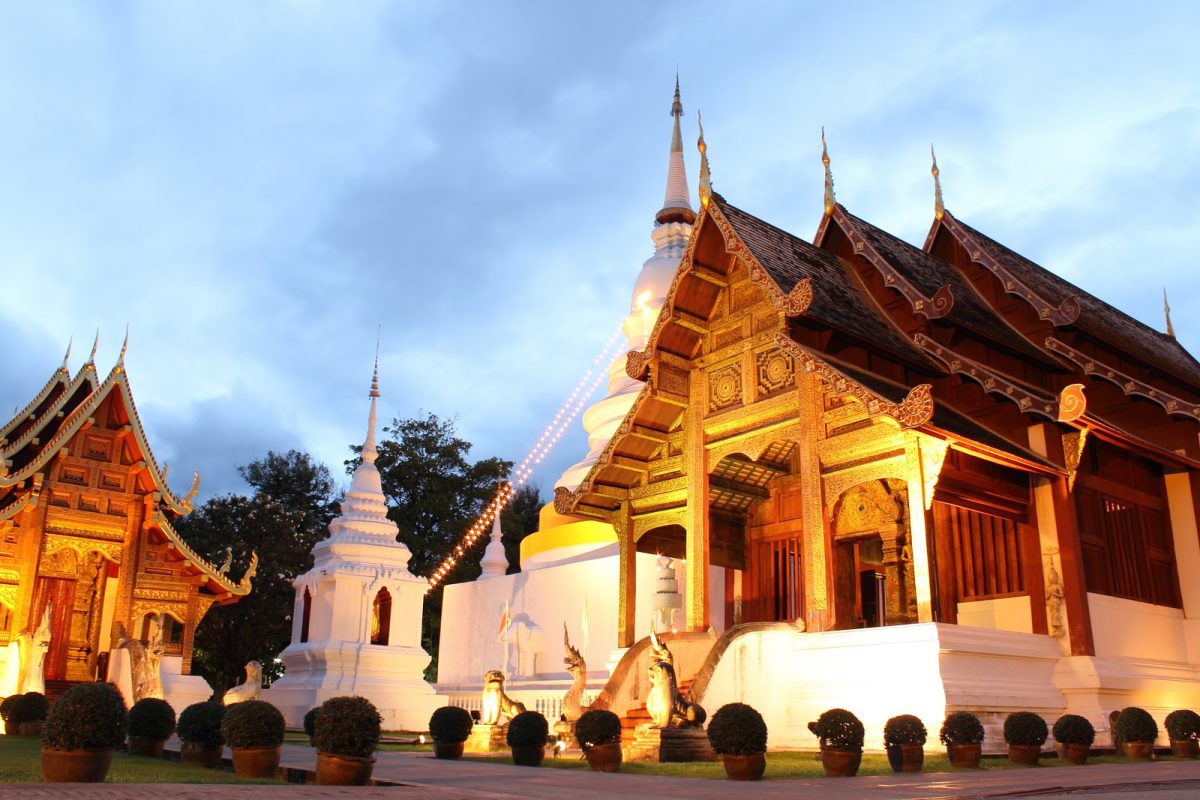
What lies beneath: Wiang Kum Kam with Wat Chang Kam and Wat Chedi Liem
The original Lanna Kingdom was seated in Chiang Rai until about 1286 when King Mengrai moved the capital to Wiang Kum Kam, just south of the current city centre of Chiang Mai. Wiang Kum Kam flooded, causing King Mengrai to move the capital to the current site of Chiang Mai, within the old city walls. Today, there are many temples and buildings dating back to the late 13th century throughout Chiang Mai.
Wiang Kum Kam was eventually buried under about 3 metres (10 feet) of mud from repeated flooding, and the city was lost to history, becoming just a legend. In 1984, this ancient city began being unearthed when restoration work began on the ancient Chedi at Wat Chang Kam, which survived the flooding to the present day. The myth became reality, and an excavation began, eventually unearthing at least 42 historical sites, several of them ancient Wats’. Today, you can visit this ancient city under the city that formed the basis of Lanna culture. The site is slightly southeast of the walled city of Chiang Mai. You can rent a horse and carriage to tour the ruins of this city below the city from Wat Chang Kam to Wat Chedi Liem.
Wat Prathat Doi Suthep
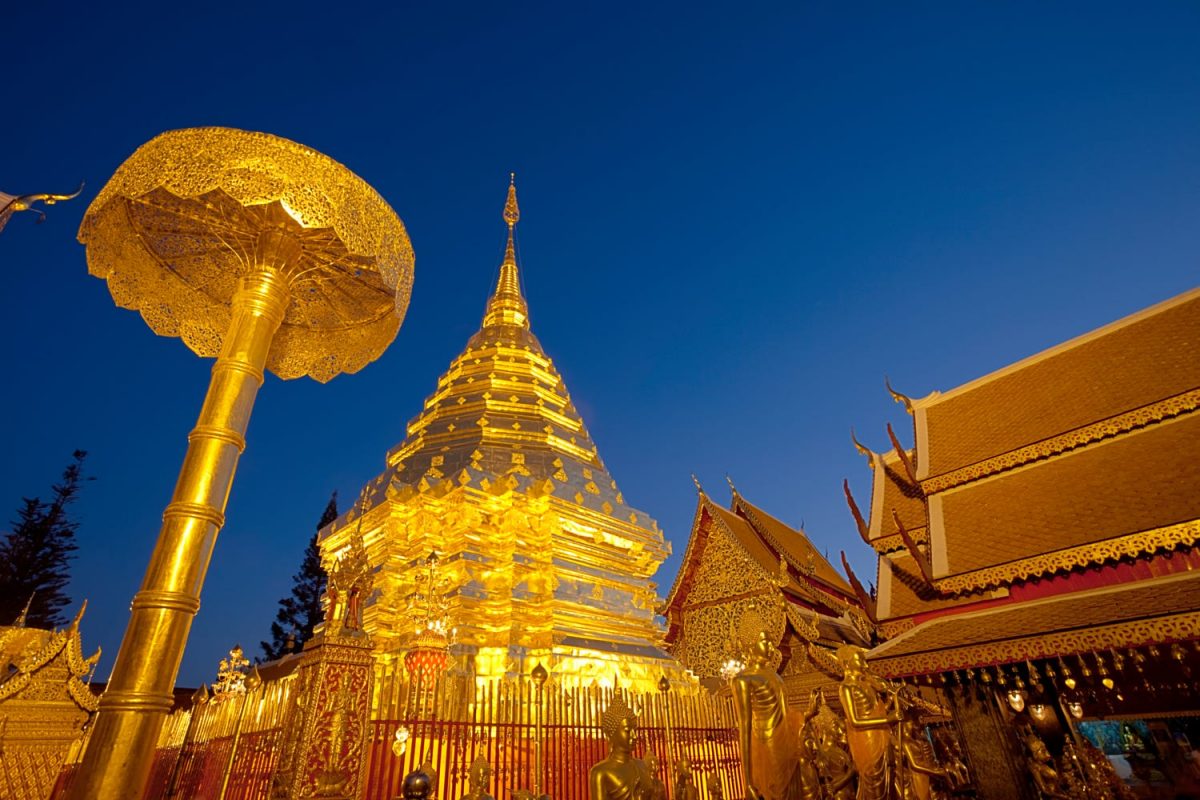 For many, the most beautiful Wat in Chiang Mai is Wat Prathat Doi Suthep with its golden stupa high on a mountain overlooking the city. On a clear day, the view of Chiang Mai below is stunning. Seeing the city from above is a good way to get oriented. To reach the golden stupa (it is actually copper plated), visitors climb 309 steps. The stupa, pagodas, statues, shrines, and view of the city below make the climb worthwhile.
For many, the most beautiful Wat in Chiang Mai is Wat Prathat Doi Suthep with its golden stupa high on a mountain overlooking the city. On a clear day, the view of Chiang Mai below is stunning. Seeing the city from above is a good way to get oriented. To reach the golden stupa (it is actually copper plated), visitors climb 309 steps. The stupa, pagodas, statues, shrines, and view of the city below make the climb worthwhile.
‘An ancient relic, thought to be the shoulder bone of the Buddha, was brought to the mountain by a white elephant.’
The temple dates back to about the 14th century. The exact dates are unknown, but legend says an ancient relic, thought to be the shoulder bone of the Buddha, was brought to the mountain by a white elephant. According to the myth, the spot where the elephant trumpeted, then died is where the first temple was built on Doi Suthep.
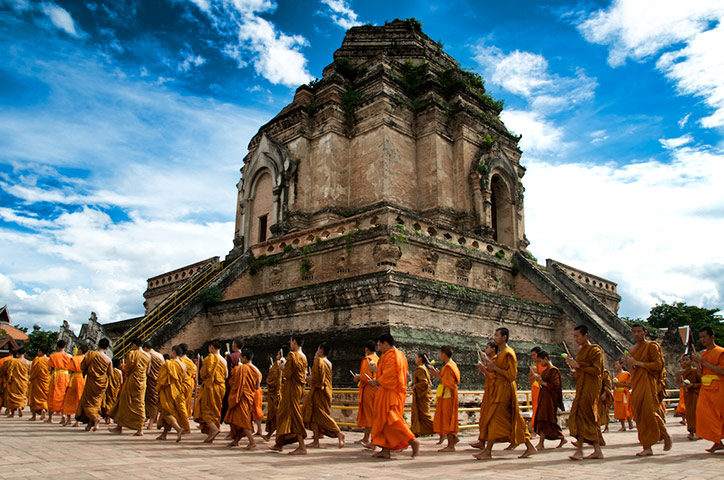 Wat Chedi Luang
Wat Chedi Luang
The average visitor may be pressed for time, and if so, the one temple that should not be missed in Chiang Mai is Wat Chedi Luang. This temple is located close to the centre of the old city. Built in the 14th century to house the ashes of the father of King Saen Muang Ma, it was left unfinished at the time of the King’s death. Wat Chedi Luang contained the Emerald Buddha until about 1545 when an earthquake damaged the structure, and it was moved to Luang Prabang, Laos. Eventually, the Emerald Buddha, Thailand’s most revered artefact, made its way to Vientiane where it remained for the next 200 some years until King Rama I captured Vientiane in 1778 and brought the relic to Bangkok where it remains today at Wat Phra Kaew on the grounds of the Grand Palace.
The Elephant Chedi: Wat Chiang Man
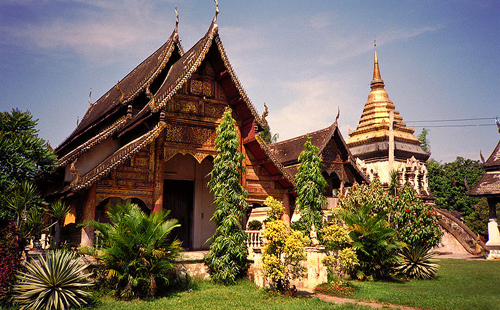
Wat Chiang Man, at the northeast side of the old city, may be the oldest temple inside the walls of Chiang Mai, dating to about 1297. Its most memorable feature is the giant Chedi with the base of elephant sculptures.
Meditate on the meaning of life at Wat Umong Thera Jan
For a peaceful, serene, and sublime experience, head west of the old city of Chiang Mai to Wat Umong Thera Jan. Umong translates roughly as “tunnel or cave,” and here, among the forest is a tunnel dating back to the 14th century built with arched brick passageways and an ancient Chedi rising high above. An emaciated black stone Buddha sits behind the stupa. A large pond stocked with fish attracts hundreds of pigeons who will flock to you if you have any hint of food. Roosters roam everywhere in this animal sanctuary. Wat Umong teaches meditation, but it is so peaceful, you may have a transcendent, back-to-nature experience without meditating.
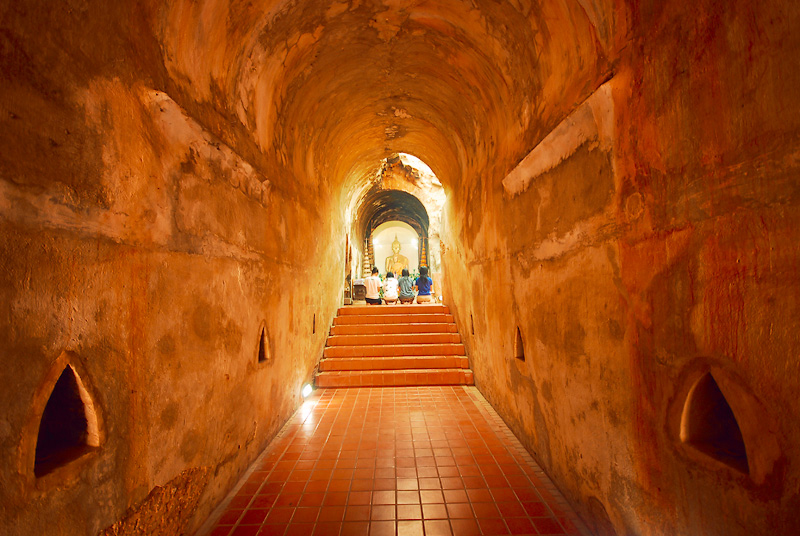 Another beautiful temple within the city walls not to be confused with the forest Wat Umong is Wat Umong Mahathera Chan near the Three Kings Monument. The “cave” here is a niche in the older structure known as The Monk’s Cave. Monks have used it for centuries to meditate on the Buddhas within.
Another beautiful temple within the city walls not to be confused with the forest Wat Umong is Wat Umong Mahathera Chan near the Three Kings Monument. The “cave” here is a niche in the older structure known as The Monk’s Cave. Monks have used it for centuries to meditate on the Buddhas within.
‘Wat Umong is so peaceful, you may have a transcendent experience even without meditating.’
Three more temples: Bupparam, Lok Molee, and Srisuphan
If time and energy allow, three decorative temples lying just beyond the city walls deserve mention. Wat Bupparam, on the road from Thapae Gate towards the river, was constructed with Burmese influence. This temple is a wonderful place to release a lantern with a monk’s assistance during Loy Krathong. It is picturesque at any time.
 Wat Lok Molee’s Chedi, was built in the 14th century and contains the ashes of several kings of the Mengrai Dynasty. The grounds, just north of the city, are small, but attractive and designed for reflection as you wander through.
Wat Lok Molee’s Chedi, was built in the 14th century and contains the ashes of several kings of the Mengrai Dynasty. The grounds, just north of the city, are small, but attractive and designed for reflection as you wander through.
Wat Srisuphan, south of the old city, lies just off Wualai Road or Silver Street, which becomes the walking street market on Saturday evenings. The ordination hall or Usboth of the temple is decorated inside and out with silver and aluminium panels. It was built in the early 1500s, with a silver and gold Ganesh Wat Bupparam statue in front, indicating the blend in this region of Hinduism and Buddhism. When lit at night, the silver temple glows. It is well worth wandering through during a Saturday walking street when the craftsmanship of the local silversmiths is also on display in the market stalls. During the day, it is possible to see the silversmiths working in an area to the side of the temple. There are far more temples to be explored in Chiang Mai, and this brief list is not meant to be exhaustive. On your next visit,  choose to see one or two, or take a day off between seeing temples to prevent burnout. I focused mainly on the temple exteriors here, but most temples are ornately decorated with Hindu and Buddhist elements, and many contain a mix of Tao, Zen, and Theravada Buddhist statuary and paintings. Due to Chiang Mai’s historical position and location between Laos and Myanmar, Laotian and Burmese influences coexist with the region’s ornamental Lanna style. A day exploring temples will leave a lasting impression of Chiang Mai’s sublime beauty.
choose to see one or two, or take a day off between seeing temples to prevent burnout. I focused mainly on the temple exteriors here, but most temples are ornately decorated with Hindu and Buddhist elements, and many contain a mix of Tao, Zen, and Theravada Buddhist statuary and paintings. Due to Chiang Mai’s historical position and location between Laos and Myanmar, Laotian and Burmese influences coexist with the region’s ornamental Lanna style. A day exploring temples will leave a lasting impression of Chiang Mai’s sublime beauty.
Jennifer Legate is a freelance writer and global nomad who was born in Africa and raised throughout Africa and Asia. Writing fiction and non-fiction, she has published several articles for business and local interest magazines. Read more and connect on social media through Jennifer’s blog: http://nomadtrailsandtales.com. She can be reached at [email protected].
———————————————————————————————————————————————–
Read the latest articles of April/May EXPAT LIFE IN THAILAND magazine at https://expatlifeinthailand.com/emagazine-april-may-2016/

